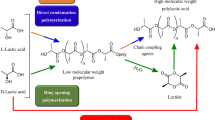Abstract
Siloxylated polypropylene fibers composed of polypropylene (PP) and aluminosiloxane (AS) were prepared by melt blending followed by spinning. The effects of blend compositions on the thermal behaviors, surface and tensile properties of PP/AS blend fibers were investigated by DSC, WAXD, SEM, static honestometer, etc. The heat of fusion of PP/AS blends decreased with increasing AS contents. In addition, the peak intensity of PP/AS blends in X-ray diffraction patterns decreased with increasing AS contents. It was observed that the silicone molecules exist and well distribute on the surface of siloxylated polypropylene fibers. From the results of the half-life period measurements, the anti-static properties of PP fibers siloxylated with AS was found to be significantly modified.
Similar content being viewed by others
References
L. Lamas, G. A. Medez, A. J. Müller, and M. Pracella,Eur. Polym. J.,34, 1865 (1998).
Y. Jois and J. Harrison,Rev. Macromol. Chem. Phys. C,36, 433 (1996).
J. J. Jeung, T. W. Son, S. K. Lim, B. H. Moon, and S. S. Kim,J. Korean Fiber Soc.,34, 16 (1997).
J. Karger-Kocsis, “Polypropylene Structure, Blends and Composites”, Chap. 9, p.273, Chapmann & Hall, London, 1995.
P. K. Pak, H. W. Kim, K. K. Na, S. S. Kim, M. C. Lee, and C. J. Park,J. Korean Fiber Soc.,36, 936 (1998).
H. H. Cho and K. H. Kim,J. Korean Fiber Soc.,35, 263 (1998).
F. Sundardi,J. Appl. Polym. Sci.,22, 3163 (1978).
M. J. Owen and T. C. Kendrick,Macromolecules,3, 458 (1970).
M. M. Alger, “Polymer Science Dictionary”, pp.362–363, Elsevier Sci. Pub., New York, 1989.
D. W. Kang and Y. M. Kim,Prospective of Industrial Chemistry,2, 3 (1999).
T. Suzuki, H. Tanaka, and T. Nish,Polymer,30, 1287 (1989).
S. Makhija, E. M. Pearce, T. K. Kwei, and F. Lily,Polym. Eng. Sci.,30, 13 (1990).
L. H. Sperling, “Introduction to Physical Polymer Science”, 2nd ed., pp.66–71, John Wiley & Sons Inc., New York, 1991.
J. M. Zeigler, “Silicone-Based Polymer Science A Comprehensive Resource”, pp.715–716, American Chemical Society, Washington DC, 1990.
D. R. Paul and S. Newman, “Polymer Blends”, Vol. 2, p.373, Academic Press, New York, 1978.
J. H. Lee, S. G. Lee, and K. Y. Choi,Polym. Sci. Technol.,9, 200 (1998).
Author information
Authors and Affiliations
Corresponding author
Rights and permissions
About this article
Cite this article
Yoon, C.S., Ji, D.S. Modification and properties of polypropylene fibers using aluminosiloxane. Fibers Polym 4, 210–214 (2003). https://doi.org/10.1007/BF02908281
Received:
Revised:
Accepted:
Issue Date:
DOI: https://doi.org/10.1007/BF02908281




